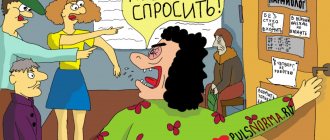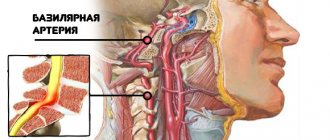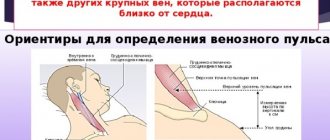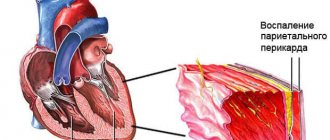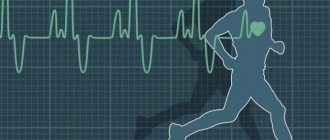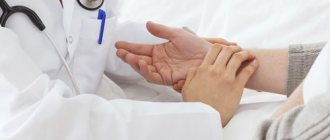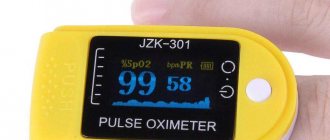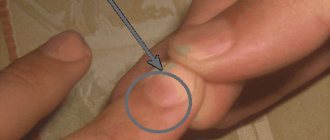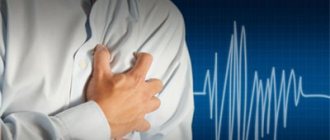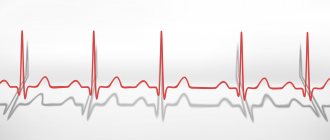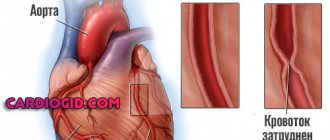Norm
First, let's define what a heart rate of 125 beats per minute means. For adults, doctors consider sixty to ninety beats per minute to be a normal value, but for children it is higher. The exact figure depends on the age category. A person’s lifestyle and environment seriously affect their heart rate. For example, in the evening it will always be higher than in the morning after waking up. During physical activity or anxiety, the value also increases.
Is a pulse of 68 beats normal for an athlete, and how can you measure it yourself?
69 beats per minute, the athlete's heart has just warmed up. Yes Yes exactly. Professional skiers, runners and swimmers are able to warm up at a heart rate of 69 beats per minute. At the same time, they can bring the pulse rate to 190-210 beats and work at it for a long/short time. And then recover in 1 minute to 120-110 beats.
This indicates their increased training and cyclical load on the heart. During training of professional athletes, amateur runners, and fitness girls, it is important to measure the pulse. For what? - so as not to drive a person’s heart, leading him to overwork or even loss of consciousness from heavy workload.
How can I do that?
- Using the old and familiar method: Counting with your hand while holding your neck. Find the pulse in the area of the neck artery. Count it within 6 seconds. Then multiply the resulting figure by 10. This way you can more accurately determine your heart rate immediately after exercise.
- Wear a heart rate monitor. This is the sensor that comes with sports watches. Dressed in the chest area. Heart rate readings are displayed on the watch screen.
- Using a pressure apparatus. The electronic device will show you your blood pressure and pulse.
We hope that our article was informative and useful for you..
Remember, a heart rate of 74 is normal and a heart rate of 79 beats per minute is normal. After all, everything depends on the characteristics of our body. From the genetics of our parents. We are able to influence and develop our heart muscle through proper physical activity. Modern technologies (pulse monitors, pressure machines, watches) give us the opportunity to measure our pulse anywhere, track its dynamics and statistics during work. We just have to use it and not overstrain our hearts.
- What heart rate is considered normal?
- Turkey records largest increase in coronavirus infections since May
- Biography of President Aliyev VS biography of President Pashinyan
- Possible candidates for secession from Ukraine following Crimea and Donbass have been named
- Why does my voice shrink? Hoarseness can be a sign of serious illness
- Baku reports a counter-offensive of the Armenian army in the south of NKR
- “The organizers of the Covid genocide will face a tribunal,” said members of the investigative commission of German lawyers
Become a member of the CLAN and every Tuesday you will receive the latest issue of “Arguments of the Week” with a discount of more than 70%, along with exclusive materials not included in the newspaper. Get premium access to a library of the most interesting and popular books, as well as an archive of more than 700 published issues for FREE. In addition, you will have the opportunity to benefit from free legal advice from our experts for a whole year.
- Enter your email address, then select any convenient payment method for your annual subscription
- Scan the QR. In the Sberbank Online application that opens, enter the annual subscription cost (490 rubles). Then send the confirmation code by email
Or
Provoking factors
A high pulse does not always indicate pathology. Some factors that provoke it are only temporary. We are talking about sudden stressful situations, fear, and taking medications.
Excessive consumption of alcoholic beverages, for example, during a celebration, as well as overeating and high emotional stress can also provoke this pathology. Doctors note that during the holidays and immediately after them, there is an increased number of patients seeking medical help due to heart problems.
Pulse measurement: basic rules
It is important to know! Doctors are shocked: “An effective way to treat HYPERTENSION and cleanse blood vessels from Malysheva. Just need it before bed. " Read more.
But to determine your true heart rate level, you need to adhere to several rules:
- It must be measured for exactly 1 minute, not 15 seconds, and the result must be multiplied by 4, as many do, even medical workers. This condition is due to the fact that during a high pulse there can be arrhythmias, which leads to a different number of beats in different 15 seconds.
- It is worth remembering that the heart rate is lower if you are in a lying position.
- Under no circumstances should you drink coffee, tea or alcohol, eat or smoke before measuring this indicator.
- The most accurate indicators characteristic of the body can be seen when making calculations in the morning after sleep and on an empty stomach.
Systematic monitoring of your pulse will help not only prevent serious diseases, but also normalize even minor deviations, and also help you get rid of poor health.
Other reasons
Why else can people experience heart rates as high as 125 beats per minute? This pathology is caused by anemia, dehydration, toxicosis of pregnant women, consumption of fatty foods, pathologies of the heart and blood vessels, strict diets, etc. If these causes are eliminated, the heartbeat usually returns to normal without special therapy.
Often people have a high pulse combined with low blood pressure. Even doctors do not always know what to do in such a situation, since almost all drugs that normalize the pulse also reduce blood pressure.
The patient should keep a diary and regularly record the measurement results in it. Based on these data, it is easier for the doctor to select the necessary treatment regimen that will help bring both indicators back to normal. It is important to find out what to do with a pulse of 125 beats per minute before a critical situation arises.
Collection of answers to your questions
Every fifth mature person after the age of forty is faced with such an ailment as a high pulse. Anyone who has detected three-digit numbers of heart beats on their tonometer should know what to do.
Normal heart rates vary from person to person, but according to statistics, in healthy people they range from 60 to 90 beats per minute.
Pulse can be measured with sufficient accuracy using modern electronic tonometers. However, this can be done without special devices by detecting the heartbeat on the wrist, temples or neck. The measurement should be carried out for a minute; Anything less is not recommended as the numbers will be inaccurate.
A high pulse in itself is not a disease, but it accompanies many dangerous diseases. Indicators above a hundred should be a serious cause for concern: if the heart contracts too frequently, it does not have the opportunity to fill, which causes oxygen starvation.
This disorder in the body must be treated immediately, otherwise the following disorders will begin to develop:
- Ventricular failure;
- Problems with blood circulation in the brain leading to stroke;
- Cardiac asthma (attacks of asthma accompanying heart disease);
- Arrhythmic shock is a disturbance in the heart rhythm, which leads to a decrease in blood pressure and the appearance of symptoms of shock.
Constantly high heart rate
A significant disruption of myocardial rhythm occupies a leading position in the structure of cardiac and vascular pathologies. Currently, there are many patients in the world whose heart rate is 125 beats per minute even at rest.
Despite the prevalence of this phenomenon, diagnosis and treatment still pose some difficulties for cardiologists. The fact is that tachycardia (a pulse value of more than ninety beats per minute) has ambiguous symptoms. In many cases, a heart rate of 120 or more is considered normal for some, but for other patients this value may be critical. In any case, a rapid pulse requires differentiated diagnostics.
Reasons for rejection
The main reasons for exceeding the norm are:
- physical exercise;
psycho-emotional stress due to stress or fear;- diseases of the cardiovascular system;
- thyroid diseases;
- lung diseases;
- poisoning;
- use of certain medications, drugs and caffeine-containing products;
- previous heart attack, etc.
This list is not exhaustive, since a rapid heart rate can indicate various diseases. The causes of deviation are divided into two types, namely physiological and pathological.
Physiological:
- physical activity (sports, work associated with physical stress);
- increased heart rate at high body or environmental temperatures;
- overweight;
- overwork;
- psycho-emotional arousal due to positive or negative emotions (sexual arousal);
hormonal changes (pregnancy, teenage changes in the body);- increase in the level of adrenaline in the blood (various stressful situations, pain shock, experienced fear, fright);
- taking various stimulants (medicines; products containing caffeine, theine, ethyl alcohol; tobacco products; narcotic substances).
The main difference between physiological causes of deviation and pathological ones is that the former do not require medical intervention. As a rule, in such cases the pulse stabilizes within a few minutes.
Pathological:
- diseases (congenital or acquired) of the heart and the cardiovascular system as a whole (heart disease, myocardial infarction);
- damage to the central nervous system (CNS);
- infectious diseases;
- thyroid diseases;
- acute poisoning;
- sudden loss of blood (various injuries);
- panic attacks and shock (state of passion).
Tachycardia caused by pathological causes requires special attention. Frequent increases in heart rate to 150 can lead to irreversible consequences.
This occurs due to the fact that the heart does not have time to fill, which leads to a reduced release of blood, resulting in oxygen starvation.
Pulse 125 beats per minute. What to do?
If the pulse increases, if this is accompanied by additional unusual symptoms or pain, you must immediately call an ambulance. While the doctor is driving, you need to calm down, lie down on the bed, and try to relax at least a little. There are several techniques that help reduce the frequency of such intense heart contraction:
- You need to do a light acupressure, carefully and with little effort pressing your fingers on the eyes.
- Find a hole in the transition area of the hand on the left hand, press on this place and hold it in a clamped state for some time.
- Perform breathing exercises, inhaling until the diaphragm opens completely, and as you exhale, strain and cough.
- Give a light neck massage and knead the muscles just below the back of the head. They also stroke the neck on the left and right at the same time.
Green tea with milk
Green tea, mixed with warm milk, is good for reducing high heart rate. This remedy quickly normalizes blood pressure and heartbeat, and also restores rhythm. Tachycardia, which is caused by temporary causes, does not require treatment.
As soon as a person returns to a normal state (rests after a run, calms down after a conflict), the pulse returns to normal. In all other cases, specialist advice is required. For example, if tachycardia is provoked by medications, the doctor will prescribe an analogue without such side effects.
Reasons for the increase
An increase in heart rate (HR) and pulse up to 180 - 200 per minute, if we consider it as an electrical process in the heart, can have different origins. The diagnosis and treatment methods depend on the nature of the rapid pulse. Therefore, some patients with such palpitations will be suitable for certain techniques and medications, while others will be suitable for completely different ones. We recommend that if your heart rate increases to such figures, do not hesitate and call an ambulance, at least to register an ECG during an attack. This is very important for further treatment.
So, a pulse of 180 per minute can occur as a result of the following processes occurring in the heart:
- Severe sinus tachycardia.
- Supraventricular or supraventricular tachycardia.
- Atrial flutter.
- Paroxysmal ventricular tachycardia.
Severe sinus tachycardia
Thus, if a pulse of 180–200 occurs in a young man during intense exercise, it must be stopped and wait for the heart rate to normalize. In all other cases, urgent medical attention is required.
It is almost impossible to independently help a patient with the listed arrhythmias (with the exception of vagal tests, which will be discussed below).
Such indicators can occasionally develop in young people 20–30 years old during intense exercise, for example, running. This cannot be allowed.
During physical activity and running, it is necessary to keep your heart rate much lower so as not to deplete the heart muscle. After stopping the load, the pulse in such people quickly slows down to normal values (recovery times vary from person to person, usually ranging from 3 to 10 minutes).
Supraventricular tachycardia
Supraventricular or supraventricular tachycardia - this condition is already a pathology. With it, signals for heart contractions are formed in one of its upper chambers (atria) and, due to anomalies in the structure of the conduction pathways, cause an attack of rapid heartbeat with a frequency of more than 140 per minute. Such a paroxysm can even last for several hours or days and requires immediate medical attention. In young people and children, a pulse of 180 per minute is often a manifestation of tachycardia in Wolff-Parkinson-White syndrome.
Getting rid of bad habits
Patients who constantly have a resting pulse of 125 are advised to completely eliminate smoking, drinking alcohol and drinking strong coffee. It is very important to avoid stressful situations, replace heavy loads with lighter ones, take vitamins, and also start your day with a contrast shower and morning exercises.
Is there a danger with a high heart rate?
If a person's pulse is 125, what does that mean? The danger of increased heart rate lies in the asymptomatic nature of this pathology. High values can only be noticed after a targeted health check or when measuring blood pressure, which not all people do. Only as tachycardia progresses do people notice the appearance of the first symptoms:
- The occurrence of weakness and fatigue.
- The appearance of rapid breathing.
- Dizziness, even to the point of fainting.
- The appearance of a feeling of heartbeat in the ears and throat.
When this pathology occurs, some patients complain of nausea, chills, and headache. If the pulse increases to critical values (for adults this is two hundred beats per minute or more), the heartbeat may be physically felt in the chest. Loss of consciousness is observed at a rate of two hundred and ten beats and above.
Some types of arrhythmia are characterized by a sudden increase in heart rate for no apparent reason and a rapid return to normal. For example, when atrial fibrillation is the provocateur of a rapid heartbeat (above one hundred beats per minute), such symptoms are included in the clinical picture of the pathology. If during such surges a person experiences pain with tingling in the chest, then this is a sign of a negative process in the heart, which will require urgent research.
A persistent high pulse combined with normal blood pressure is common in patients with tachycardia. But these values are not always related to each other. The absence of signs of hypertension is not an indicator of health, but only serves as a mask for serious symptoms associated with heart disease. Only an experienced cardiologist can determine the presence or absence of a problem.
If frequent episodes of increased heart rate are observed, accompanied by discomfort, dizziness and numbness of the extremities, a cardiovascular examination should be performed. If the cardiologist does not find any serious abnormalities, you should continue to find out the causes of the abnormal condition by contacting other specialists.
Collection of answers to your questions
Every fifth mature person after the age of forty is faced with such an ailment as a high pulse. Anyone who has detected three-digit numbers of heart beats on their tonometer should know what to do.
Normal heart rates vary from person to person, but according to statistics, in healthy people they range from 60 to 90 beats per minute.
Pulse can be measured with sufficient accuracy using modern electronic tonometers. However, this can be done without special devices by detecting the heartbeat on the wrist, temples or neck. The measurement should be carried out for a minute; Anything less is not recommended as the numbers will be inaccurate.
A high pulse in itself is not a disease, but it accompanies many dangerous diseases. Indicators above a hundred should be a serious cause for concern: if the heart contracts too frequently, it does not have the opportunity to fill, which causes oxygen starvation.
This disorder in the body must be treated immediately, otherwise the following disorders will begin to develop:
- Ventricular failure;
- Problems with blood circulation in the brain leading to stroke;
- Cardiac asthma (attacks of asthma accompanying heart disease);
- Arrhythmic shock is a disturbance in the heart rhythm, which leads to a decrease in blood pressure and the appearance of symptoms of shock.
Life expectancy with rapid heart rate
Let's find out how long you can live with a constant heart rate of 120-125 beats per minute?
According to the observations of scientists, at a value above ninety beats per minute, the mortality rate increases slightly compared to patients who have a low heart rate. Experts have calculated that with an increase in the rate for every ten blows, the risk of death increases by an average of sixteen percent (ranges from 10% to 22%).
At the same time, for non-smoking men, the risk of death increases by fourteen percent, and for smoking men - by twenty. It is difficult to answer the question of how long you can live with a constant high heart rate, but the overall life expectancy in any case is noticeably reduced.
Resting heart rate is one of the most important parameters of cardiovascular health in humans. It was noted above that the normal level ranges from sixty to ninety beats per minute. It is worth noting that in the morning a pulse of 125 beats per minute is considered a particularly dangerous symptom. With such a pathology, a mandatory medical examination and elimination of the causes of this condition are required.
Movie 128 heart beats per minute
We don't know how many tragedies happened as the Silk Road developed. We only know that he helped countries develop. Trade, tourism (if you can use this concept in relation to the Silk Trade Road), and all this mutually enriched all countries. It developed trade, developed culture, introduced something new into customs, rites and rituals. Nothing has fundamentally changed in the relations between the countries even now. When a country develops, whether through war, technology, or attracting other intellects from other cultures, the country rises and begins to dictate its terms. This has now happened to the USA. We now clearly know what an American office is, what the American dream is, what American English is, what American society is. And what is adrenaline sports?
The pressure that Americans feel while sitting in an American office and trying to break through to the American dream from this position, of course, leads to an American vacation, which can only be enjoyed with the help of drugs, extreme sports, and a certain type of music. It, unlike classical music, does not imply an associative series, the emergence of fantasies, appeal to memory, or some kind of romanticism. The best, most powerful way to relieve stress, and this is known, is sex. Therefore, disco music excites precisely those levels of our instincts that allow us to achieve sexual arousal.
The rhythm itself at low frequencies physiologically excites the most ancient structures of the brain - the midbrain, to which shamans usually appeal. Psychedelic music that accompanies suggestive sessions also affects these brain structures. They also arouse desire. The American open office, where people sit all day long wearing headphones that constantly itch and you can’t switch off, causes depression and overwork. But such offices are pleasant for the employer. Here you don’t have to think about working conditions, here you can calmly make the most of it, appealing to the fact that 20 people, or even more, will come instead of you. In the modern world, no one is going to take care of their employees, as did the founder of the business approach, Henry Ford. It’s easier to replace one professional worker with a bunch of non-professionals, so that he, not yet understanding the intricacies, obediently follows your orders. Which is what the main character of the film did successfully.
All these moments are amazingly reflected in a seemingly empty, club, disco story. As always, there is a lot of deep meaning to be found behind the simplicity. Not entirely innocent, but also not deeply vicious, but rather “modern” boys, just trying to break through in the crazy world of money and cynicism, end up in different ways: some - a complete fiasco, some, not being an avid drug addict, die from an overdose. The main character gets to the foot of the American dream through humiliation, through an understanding of the inevitable and irrevocable, through his own meanness and betrayal, the nobility of those whom he betrayed, and payment with his nobility for the nobility of another.
The creations of Hubbard, Carnegie, modern pseudo-psychologists and pseudo-therapists, NLP and many other zombifying technologies with which American society is stuffed do not have a positive effect on Russian society, since we have different mentalities, we are mentally healthier. We have our own stresses, we, unfortunately, have not avoided taking drugs and going to nightclubs, but in fact, these Americanisms are not a necessary component for us. We do not need American education, healthcare, American bureaucratic colossus, American cynicism towards people, human juice squeezer, and American pseudo-religion - from Mormons to Scientologists. All this can be considered a stage for us that does not need to go through. The devil of this film lies not so much in the main character, but in the details. The main character of the film does the same thing as several hundred main characters did before him - he searches for himself through the creation of his track, and ultimately finds himself. Moreover, here the main character does not demonstrate any special intelligence: in order to create his own track, he betrays, experiences death, speculates on his own decency, and separates people. Some other heroes found smarter ways to come to their senses.
High pulse with normal blood pressure
Pulse is a very important indicator of the state of the cardiovascular system. If it is within normal limits, this indicates that our “motor” is working without any serious disturbances.
People's blood pressure ranges on average from 100 to 140 millimeters of mercury (systolic) and from 70 to 90 (diastolic). Throughout the day, the values may vary somewhat, which is associated with various external factors, as well as blood viscosity, elasticity of the vascular walls, their resistance, and the intensity of heart contraction. Often, when your heart rate increases, your blood pressure also increases. But sometimes there is a pulse of 125 with normal pressure. Why is this happening?
There is no need to worry if the heart rate increases more than ninety-five beats, and the pressure values are within the normal range. This happens against the background of physical and psychological overload. This is also a consequence of lack of sleep or a powerful emotional shock.
A similar picture is observed when carrying a child. In such situations, tachycardia is considered a temporary phenomenon. When the provoking factors go away, the heart rate returns to normal on its own. True, with normal pressure there are also pathological reasons for such acceleration. A pulse of 125 with low blood pressure is often observed in the following situations:
- Anaphylactic shock.
- Large blood loss.
- Intoxication, poisoning.
- Myocardial infarction.
- Cardiopsychoneurosis.
- Hormonal disorders.
With high blood pressure, the reasons for a rapid pulse may be:
- Oncological diseases.
- Anemia.
- Problems with the thyroid gland.
- Respiratory system disorders.
What diagnostic tests are needed?
If the heart rate increases from 115 - 120 to 125 - 130 per minute, you must first confirm this disorder - do a regular ECG at rest. The general practitioner also prescribes a general blood test to rule out anemia, infections, tumors and other nonspecific causes of rapid heartbeat.
A blood test for the content of TSH and T4 is very useful - hormones, changes in the content of which indicate a dysfunction of the thyroid gland. Additionally, ultrasound of the adrenal glands, chest radiography, and spirometry may be prescribed.
If non-cardiac causes of rapid pulse are excluded, an in-depth cardiac examination is prescribed:
- daily ECG monitoring to determine at what time of day tachycardia is more pronounced, whether it occurs during sleep, whether it is accompanied by rhythm disturbances or signs of lack of oxygen in the heart muscle;
- Echocardiography, or ultrasound of the heart to determine structural abnormalities and malformations, as well as to diagnose heart failure and scar changes in the myocardium;
- MRI of the heart.
Causes of rapid heart rate with normal blood pressure
They are usually the following:
- Failure of the optimal rest regime for the body.
- The presence of pneumonia, bronchial asthma, bronchitis, occurring in an acute form.
- Obesity.
- The influence of hormonal imbalance and iron deficiency anemia, as well as anemia.
- The presence of acute viral diseases.
- The appearance of infectious pathologies with complications in the heart.
- Development of spinal osteochondrosis.
- Consequence of bad habits.
- The presence of abnormalities of the vascular system.
- Long-term use of potent medications.
- The development of vitamin deficiency and chronic kidney or liver diseases.
- VSD, as well as thromboembolism.
Sinus tachycardia of the heart - what it is, symptoms and treatment
Rapid heartbeat - is it dangerous or not? It all depends on what caused the increase in heart rate. It’s one thing if the attack began after a fright, and another when there are chronic diseases.
So, let's figure out what it is - sinus tachycardia of the heart, is it dangerous and why, what are its symptoms and what is the treatment.
Main characteristics
Sinus tachycardia is a form of arrhythmia, what does it mean? This type of tachycardia is caused by a disorder:
- generation of impulses by the sinus node, which controls heart rhythm;
- conduction of impulses from the sinus node to the ventricles.
The sinus node is the part of the heart that produces sinus rhythm. There, a wave of excitation arises, which spreads to the heart and contributes to its synchronous functioning.
In adults, the limit is considered to be a heart rate (HR) of 100 beats per minute . For children, this indicator is calculated by age, and a deviation is considered to be an excess of heart rate by 10% of the age norm.
With sinus tachycardia, the heart rate is 95–130 beats per minute (without physical activity), 150–160 with exercise . For athletes, this figure can reach 180–240 beats.
Forms
There are functional and pathological (or long-term) forms.
Functional
Functional is understood as an acceleration of sinus rhythm in response to stress (physical or emotional) or fever. The heart rate returns to normal as soon as the cause is eliminated.
Pathological
The pathological form occurs at rest. It is caused by extracardial and intracardial factors.
Differences from other species
There are also paroxysmal tachycardia and ventricular fibrillation.
Sinus tachycardia differs from the paroxysmal form in that in the first case the attack begins suddenly, the heart rate is 120–250 beats per minute , while maintaining the correct rhythm during the attack.
With physiological sinus tachycardia, heart rate increases smoothly; the paroxysmal form is characterized by suddenness.
Ventricular fibrillation is a life-threatening condition in which blood is not pumped out of the heart and the organ stops working . In this case, a chaotic contraction of myocardial fibers occurs (250–480 beats per minute).
Usually the symptom occurs as a complication of extensive transmural myocardial infarction, as well as due to shock and severe potassium deficiency in the blood.
Ventricular fibrillation requires urgent medical attention!
Development mechanism
Sinus tachycardia develops according to one of the scenarios:
- Activation of the symptomatic system, which is part of the nervous system. The substance norepinephrine from nerve fibers activates the sinus node.
- Decreased activity of the parasympathetic system. Its substance acetylcholine inhibits the generation of impulses, which leads to a decrease in heart rate. When the activity of the parasympathetic system decreases, the role of the sympathetic system increases, resulting in an increase in heart rate.
- Direct impact of influencing factors on the sinoatrial node during normal functioning of the sympathetic and parasympathetic nervous system. Active substances act on impulse-generating cells and excite them.
Causes
The symptom occurs more often in young people . The reason for this is the immaturity of the nervous system. The body needs a balance of the sympathetic and parasympathetic nervous systems. But at a young age, the balance is poorly maintained, so imbalances arise, which causes an attack (cardioneurosis).
Various factors contribute to the development of sinus tachycardia. Physiological form - reaction to stress, stress, high temperature. As for pathological TS, a distinction is made between extracardiac and intracardial groups of factors.
Extracardiac factors include:
- Neurogenic - develops in individuals (usually young women) with an unstable nervous system, with a tendency to neuroses, depression, etc., which is explained by the high sensitivity of heart receptors to stress hormones.
- Toxic - caused by toxic substances - alcohol, tobacco, as well as internal factors (thyrotoxicosis, adrenal tumor - pheochromocytoma, more often manifested in women), chronic infections (tuberculosis, tonsillitis).
- Medicinal - occurs due to activity or overdose. This is how hormonal drugs, drugs for the treatment of lung diseases, hypertension, and antidepressants affect the body.
- Hypoxic - this is how the body reacts to oxygen deficiency. In turn, the cause of hypoxia is diseases of the respiratory system and blood pathologies, in which the delivery of gas to organs and systems is disrupted (anemia, leukemia, chronic blood loss, etc.).
Intracardiac factors are caused by heart disease . Often (but not always) the development of sinus tachycardia in people with heart disease indicates heart failure or impaired left ventricular function, since then there is a decrease in ejection fraction or a clinically significant deterioration of hemodynamics within the heart.
Most often, the intracardial form of TS develops with the following pathologies:
Find out more about the disease from the video:
Symptoms
During an attack of sinus tachycardia, the patient may experience the following symptoms:
- “fluttering” of the heart, rapid heart rate;
- dyspnea;
- heaviness, “tightness” in the chest (occurs when there is no load);
- dizziness, loss of consciousness;
- compressive chest pain (no longer than 5 minutes) - with coronary heart disease;
- general weakness, decreased performance, intolerance to physical activity (in the pathological form).
Functional TS usually does not require medical intervention and goes away after the provoking factor is eliminated. However, manifestations such as chest pain and loss of consciousness are a reason to urgently consult a doctor.
Diagnostics
A complete picture of the severity of the condition is obtained after the examination. Diagnostic activities include:
- anamnesis analysis - the patient is asked to describe sensations, possible cause-and-effect relationships, the presence of chronic diseases, living conditions, bad habits, etc.;
- physical examination - examine the skin, study the condition of hair and nails;
- auscultation - the respiratory rate, wheezing and heart murmurs are determined, which makes it possible to identify the cause of the pathology;
- general blood test - shows anemia, leukocyte level (increases with chronic disease);
- biochemical blood test - gives an idea of the level of cholesterol (low and high density), glucose, potassium, creatine, urea, allows you to exclude diabetes mellitus, kidney disease, changes in the chemical composition of the blood;
- urinalysis (general) - excludes diseases of the urinary tract;
- hormonal analysis - to determine the level of hormones produced by the thyroid gland;
- echocardiography (echocardiography) - detects structural changes.
The main and most informative study is electrocardiography, or ECG, as well as a Holter electrocardiogram (recording is carried out continuously for 24–72 hours, at rest and during exercise).
ECG signs of sinus tachycardia are presented in this illustration:
The patient is prescribed consultations with a psychotherapist, otolaryngologist, and other specialists.
How and with what to treat
the goal of treatment is to eliminate the cause that causes the attacks, since sinus angina is a symptom of other ailments. Therapy is selected and prescribed by a cardiologist.
Correction of daily routine and habits
This block of activities includes:
- giving up bad habits - drinking alcohol, drugs, smoking;
- diet correction - patients are recommended to eat foods rich in fiber and give up fatty, hot, spicy foods, reduce the amount of coffee and tea;
- adherence to sleep and rest patterns.
Elimination of chronic diseases
If the examination reveals that the cause of tachycardia is an infection, then treatment is aimed at eliminating it. The patient is prescribed sanitation for diseases of the oral cavity, removal of a diseased tooth or inflamed tonsils, and antibiotic therapy .
In case of iron deficiency and anemia, it is recommended to take medications with this element; in case of bleeding, the administration of solutions is recommended to restore the volume of the blood mass.
Lack of oxygen due to bronchopulmonary diseases is eliminated by introducing gas through a catheter into the nasal passages.
Prescribed drugs
Medicines to eliminate the tachycardia itself are prescribed when the patient cannot tolerate the rapid heartbeat. For sinus tachycardia, the following drugs are used:
- beta blockers - block receptors that respond to the stress hormones adrenaline and norepinephrine;
- if-channel inhibitors - control the degree of excitation in the sinus node, heart rate;
- sedatives based on medicinal plants - motherwort, valerian root, hawthorn.
Recovery
The patient may be indicated for spa treatment in Kislovodsk and other health resorts if the cause is intracardial factors. In other cases, rehabilitation measures depend on the underlying disease.
It is recommended to follow these rules:
- eliminate intense emotional stress - at home and at work;
- sleep 8 hours a day;
- eat right, avoiding spicy and fatty foods;
- eat vegetables, herbs, fish (especially sea fish) every day;
- give up bad habits;
- do gymnastics (at least 30 minutes daily);
- control body weight.
Controversial techniques
Doctors argue about whether it is possible to take cardiac glycosides for sinus tachycardia. This applies in particular to digoxin. According to the Russian method, a combination of beta blockers and digoxin, sometimes with calcium antagonists, achieves clear control over heart rate.
The range of drugs for the treatment of tachycardia is limited, since it may have side effects with long-term therapy. If drug therapy is not possible, resort to electrical stimulation of the myocardium.
Sinus tachycardia in the elderly is treated surgically, with pacemakers installed, which eliminates the blockade of the atrioventricular node.
Forecast
The prognosis is quite serious if sinus tachycardia is a symptom of heart failure or left ventricular dysfunction. Then the course of the disease worsens.
It is important to remember that sinus tachycardia can be a manifestation of other ailments . But in childhood, pregnancy and adolescence this is often the norm. Then the medications can be harmful.
Therefore, taking any action on your own is prohibited. Only a specialist can determine the degree of danger and the advisability of prescribing medications after an extensive examination.
2 Comments
Source: https://oserdce.com/serdce/aritmii/sinusovaya-taxikardiya.html
